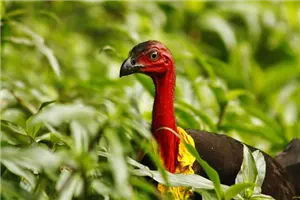
Australian brush turkeys are a protected species as are all native animals. Brush turkeys are generally wary of humans and they feed mainly on insects, seeds and fallen fruits. They find food by raking the leaf litter or breaking open rotten logs with their large feet. The majority of food is obtained from the ground, with birds occasionally observed feeding on ripening fruits among tree branches.
Appearance
Brush turkeys have deep blue-black plumage, bright head feathers, a broad flat tail and a general turkey-like appearance. Brush turkey chicks look much like quails, with plain rich brown feathers over their entire bodies. As they mature they lose the feathers on their heads and necks, where the bare skin turns a deep pink colour.
Breeding
Vegetation is gathered from the garden or forest floor by the male brush turkeys who build a large distinctive incubation mound, which can be up to 4m wide and up to 2m high. A female will then lay between 18 and 24 white eggs in the mound, with intervals of two to three days between the laying of each egg. As the vegetation in the mound decomposes, it gives off heat which warms the eggs. The optimum incubation temperature is 33-35 degrees celsius and the male brush turkey maintains this temperature by removing and adding layers to the mound.
Temperature regulation is the only assistance the parents provide to their offspring. The young brush turkeys hatch after about seven weeks, fully feathered and able to run and fend for themselves. They dig their way through the layers of the mound and into the open air and they are able to fly just a few hours after hatching.
Brush turkeys in the garden
People with carefully planned and landscaped gardens can find brush turkeys difficult at breeding time, as they remove vegetation, earth and mulch to create their incubation mounds. In a few hours, the birds can strip away closely planted natives and light, moist mulch used frequently in landscaped gardens. Heavier ground coverings (such as river gravel) and tree guards can reduce the impact on valuable and vulnerable plants. Once a male brush turkey has started to build its mound, it is extremely difficult to prevent it from continuing its efforts.
National Parks and Wildlife Service NSW advise that if a mound has been established for several weeks with a male Brush-Turkey maintaining it, the nest should be left until the young disperse. A period of 60 days should be left to allow the eggs to hatch, and the young emerge and disperse.
To deter future nesting, although no single method has proven effective in all situations, you can try:
- Spreading a heavy tarpaulin over the mound and weighing it down, to prevent the bird from working
- Diverting the bird’s attention to a less attractive or valuable area of your garden, by building a household compost mound.
- Ideally, the compost mound should be next to at least one large tree providing 80 to 95 per cent shade.
- The brush turkey may be attracted towards the area and may eventually take over the compost mound as its nesting ground.
Rescuing brush turkeys
If you find a sick or injured brush turkey please call WIRES Rescue Office 1300 094 737 or fill in the Rescue Form.
If the bird is sick or injured it will need to see a vet before coming into care, if you are able to safely contain it, you can keep it in a quiet, dark, warm place e.g. wrapped in a towel in a ventilated box or carrier with a lid while you transport it to the nearest vet. If you let WIRES know which vet you’ve taken the bird to, we will follow up with the vet directly to bring them into care after they have been vet assessed and received any necessary treatment.
Much of this content has been sourced from the OEH website: www.environment.nsw.gov.au
To access 24/7 rescue advice and assistance for sick, injured and orphaned native animals call 1300 094 737, or fill in the online rescue form.
Sign Up for Wildlife News
Stay in touch and get our regular rescue stories, WIRES updates and a free copy of our 15 Ways to Help Wildlife ebook
